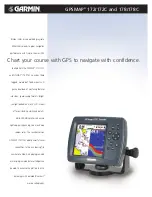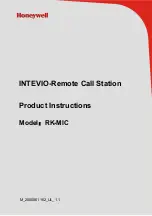
Note:
In areas of extreme EMC interference, some slight interference may be noticed on the
product. Where this occurs the product and the source of the interference should be separated
by a greater distance.
For
optimum
EMC performance we recommend that wherever possible:
• Raymarine equipment and cables connected to it are:
– At least 1 m (3 ft) from any equipment transmitting or cables carrying radio signals e.g. VHF radios,
cables and antennas. In the case of SSB radios, the distance should be increased to 7 ft (2 m).
– More than 2 m (7 ft) from the path of a radar beam. A radar beam can normally be assumed to
spread 20 degrees above and below the radiating element.
• The product is supplied from a separate battery from that used for engine start. This is important
to prevent erratic behavior and data loss which can occur if the engine start does not have a
separate battery.
• Raymarine specified cables are used.
• Cables are not cut or extended, unless doing so is detailed in the installation manual.
Note: Where constraints on the installation prevent any of the above recommendations
, always
ensure the maximum possible separation between different items of electrical equipment, to
provide the best conditions for EMC performance throughout the installation
RF interference
Certain third-party external electrical equipment can cause Radio Frequency (RF) interference with
GPS, AIS or VHF devices if the external equipment is not adequately insulated and emits excessive
levels of electromagnetic interference (EMI).
Some common examples of such external equipment include LED spot or strip lights, and terrestrial
TV tuners.
To minimize interference from such equipment:
• Keep it as far away from GPS, AIS or VHF devices as possible.
• Ensure that any power cables for external equipment are not entangled with the power or data
cables for GPS, AIS or VHF devices.
• Consider fitting one or more high frequency suppression ferrites to the EMI-emitting device. The
ferrite(s) should be rated to be effective in the range 100 MHz to 2.5 GHz, and should be fitted
to the power cable and any other cables exiting the EMI-emitting device, as close as possible to
the position where the cable exits the device.
Compass safe distance
To prevent potential interference with the vessel's magnetic compasses, ensure an adequate
distance is maintained from the product.
When choosing a suitable location for the product you should aim to maintain the maximum possible
distance from any compasses. Typically this distance should be at least 1 m (3 ft) in all directions.
However for some smaller vessels it may not be possible to locate the product this far away from a
compass. In this situation, when choosing the installation location for your product, ensure that the
compass is not affected by the product when it is in a powered state.
GPS location requirements
In addition to general guidelines concerning the location of marine electronics, there are a number of
environmental factors to consider when installing equipment with an internal GPS antenna.
Mounting location
•
Above Decks (e.g. open air) mounting:
Provides optimal GPS performance. (For equipment
with appropriate waterproof rating.)
•
Below Decks (e.g. enclosed space) mounting:
GPS performance may be less effective and may
require an external GPS receiver, mounted above decks.
23
Summary of Contents for Axiom Pro 12
Page 2: ......
Page 4: ......
Page 8: ...8 ...
Page 12: ...12 ...
Page 32: ...32 ...
Page 50: ...50 ...
Page 54: ...54 ...
Page 76: ...76 ...
Page 86: ......
Page 87: ......
Page 165: ......
Page 170: ......
Page 178: ...12 ...
Page 214: ...48 ...
Page 222: ...56 ...
Page 228: ...62 ...
Page 272: ...106 ...
Page 296: ...130 ...
Page 302: ...136 ...
Page 310: ...144 ...
Page 320: ...154 ...
Page 344: ...178 ...
Page 354: ......
Page 358: ......
Page 359: ......
















































